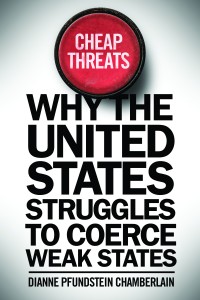My book Cheap Threats: Why the United States Struggles to Coerce Weak States is now available for pre-order from Georgetown University Press and Amazon. In Cheap Threats, I argue that the United States struggles to use threats[1] effectively against weak states (like Iraq, Libya and Haiti) because it has adopted many strategies that render the use of military force relatively cheap. Because force is cheap, the threat to use force does not convince weak targets of the United States’ compellent threats that the United States is highly motivated. These targets will resist in the face of a cheap threat–even one issued by the state with the world’s most powerful military–because the cheapness of U.S. military action suggests that the United States lacks the motivation to pursue a long and costly victory against them. In other words, by making the use of force cheap, we have made threats against weak states less effective.[2] This is a problem because the United States often chooses to launch costly military operations when the threat of force alone is insufficient to change the targeted state’s behavior.
How can I possibly argue that the use of force is cheap for the country that spends nearly as much as the rest of the world combined on defense each year? The first chapter of the book explains in detail the strategies that the United States has adopted to minimize the human, political, and financial costs of employing force—including the use of deficit spending to fund major military operations like the wars in Iraq and Afghanistan. I won’t repeat these arguments here, except to highlight one of the major cost-minimizing strategies that I discuss in the book: the transformation of the American military since the 1970s.
Before 1973, the United States relied on some type of conscription, i.e., compulsory military service, to fight its wars. After the backlash against selective service in the Vietnam War, during which privileged young men were better able to escape the necessity of military service, the United States eliminated conscription and has since relied on an all-volunteer force (AVF). This has led to an increase in education, retention, and professionalization in the service, but the U.S. military is not a representative institution: new recruits are disproportionately drawn from the lower socio-economic classes; the southeastern states tend to be over-represented; minorities are over-represented in the enlisted ranks while whites dominate the officer corps, etc. As a result, the wealthy, educated individuals who are most likely to be members of the decision-making class (members of Congress, scholars at think tanks, i.e., those responsible for making decisions about when and where we fight wars) are insulated from the burdens of military service and increasingly unlikely to have any direct connection to the military themselves. In addition to opting for a volunteer force that shields the vast majority of the American public from the privations and sacrifice of military service, the United States has also relied increasingly on private military contractors to perform functions formerly reserved for the military. The casualties suffered by these individuals are not counted in official figures, which helps to further insulate the general public from the true human toll of America’s military conflicts.
Why does this matter? It matters because strategies that minimize the impact of the use of military force on the American population make it much, much easier for policy-makers to choose to use military force. (Can we imagine that the George W. Bush administration would have been able to sell the war in Iraq if conscription had been in place in 2003?) The AVF makes it much less politically costly to use force, and hence makes it more likely that force will be used. My book demonstrates, however, that such strategies that make the use of force cheaper also undermine our ability to successfully threaten weak states with the use of force.
An op-ed by former Army Captain Matt Gallagher in last Sunday’s New York Times highlights an important and related trend: the growing national obsession with special operations forces (Army Rangers, Delta Force operators, Navy SEALs, etc). “The mythos of Special Operations has seized our nation’s popular imagination, and has proved to be the one prism through which the public will engage with America’s wars…We like our heroes sanitized, perhaps especially in murky times like these.” In the midst of an overall downsizing of the U.S. military, the number of special operations forces continues to rise. Perhaps more importantly, these types of forces conduct their missions in the shadows, with limited Congressional and public oversight of where they are sent (139 countries in 2015, many of these for training missions). Out of sight, out of mind.
As the American public becomes increasingly enchanted with the myth of the commando running secret missions in bad neighborhoods while bathed in the green glow of night vision goggles, it is pushing the United States further down this path of seemingly cheap, low-commitment, sanitized military force. As Cheap Threats argues, however, this will continue to undermine our ability to wield threats of force effectively.
[1] For example, the United States might threaten a small state with air strikes if it does not admit weapons inspectors.
[2] The theory I advance in the book suggests that threats against more powerful states will be more effective because they are more costly to issue and to execute. See the book for a more thorough explanation.

